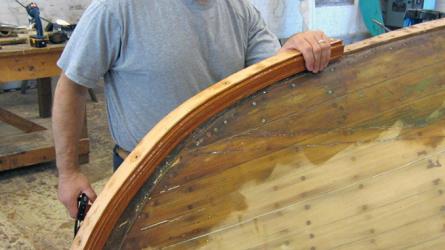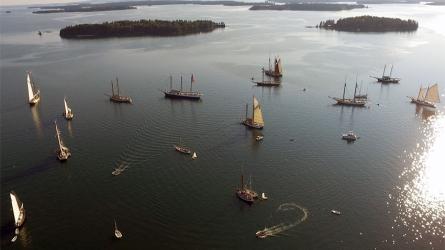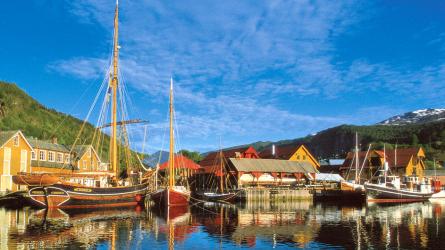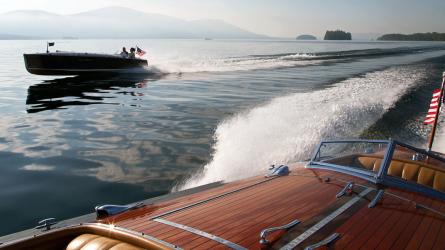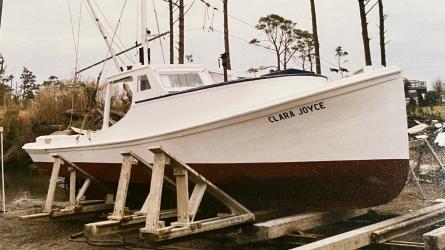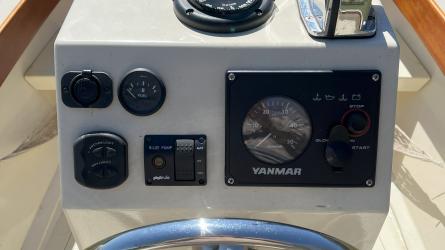Jackyard Topsails
A Tiger of a Sail
A Tiger of a Sail
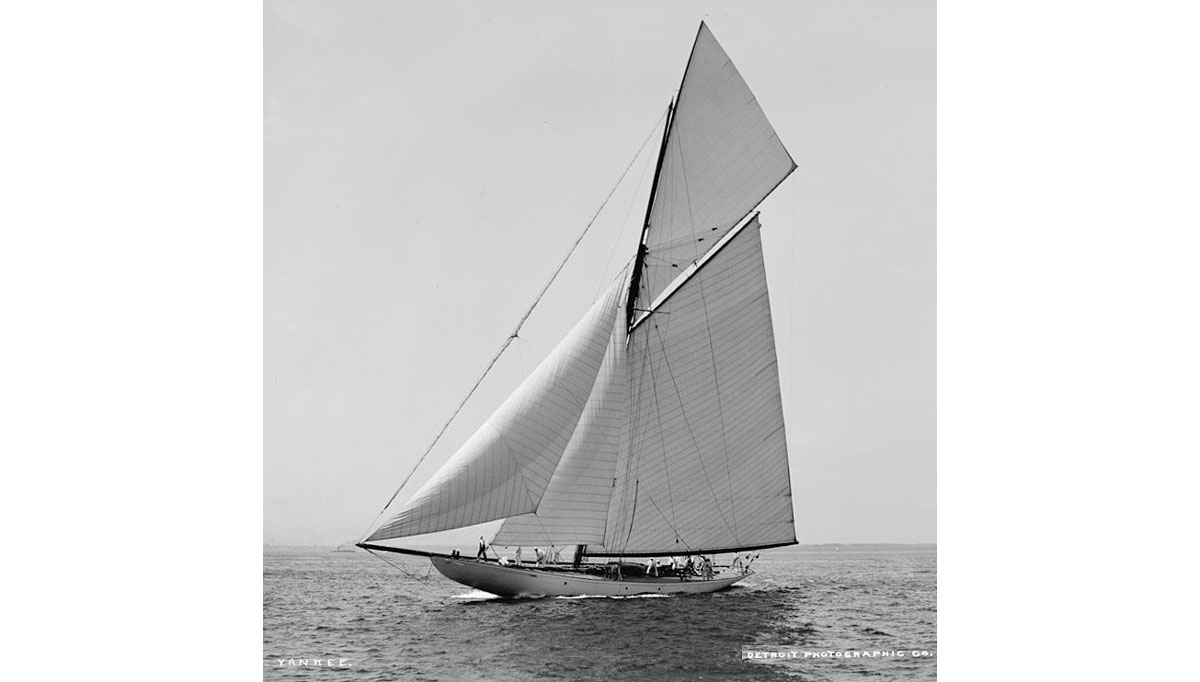
The NY70 YANKEE sailing with her jackyard topsail set. From the Library of Congress, LC-DIG-det-4a15407.
A jackyard topsail is rarely seen today, and there is good reason for that. The jackyard topsail is a sail with murder on its mind, swinging long spars along the deck, intent on sweeping the crew overboard. If you see a jackyard topsail set today, such as on the P-boat JOYANT or on the NY50 SPARTAN, you should take notice, because under a jackyard topsail lies a brave captain and braver crew, whose full attention will be on that large sparred piece of canvas hoisted high into the sky. In the image of the Herreshoff NY70 YANKEE (above) the jackyard is nearly as long as the gaff. The jackyards on RELIANCE’s topsail, shown in the Library of Congress photo below, were 68′ and 58′ long according to the Herreshoff Museum archives. Imagine swinging the unstayed mast of a 50′ sailboat along the deck while under way… that’s what a jackyard topsail would feel like to those handling it on deck, two of them.
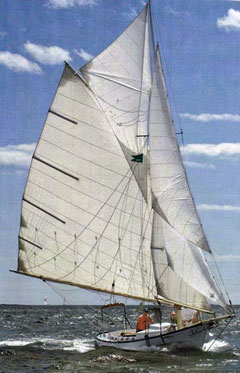
WoodenBoat’s BELFORD GRAY, with topsail set. Courtesy of WoodenBoat School.
A topsail… a normal friendly topsail, without the additional spar extending beyond the gaff… is a light triangular sail set as high as possible, in an effort to set more sail and catch the higher, often stronger, air moving above the gaff. A traditional fore-and-aft rigged schooner might want to set a little more sail area than her working lowers provide, especially in light air. She has to have a topmast in place, as many schooners do, and she might set two topsails at one time, one on the main, and one on the foremast. In an engineless boat, say a working Friendship sloop like the BELFORD GRAY shown here, you’d want a topsail to get home when the breeze fails, catching that bit of wind that would otherwise be lost.
A topsail is set from the deck with a simple arrangement of sheets and halyard, admittedly using a lot of long lines. It requires vigorous hoisting with all eyes lifted skyward. A topsail on a large schooner can be a fun sail to hoist and set because it is relatively small compared to the big working gaff sails, and because the sight of the ancient sail, set and drawing high above the rest of the rig, is an exciting and heart-pumping spectacle, a thing to hold in reverential stance, and usually worth the effort involved, at least in the eyes of a sailor.
But a JACKYARD topsail is another animal altogether, a tiger outside the cage compared to the friendly topsail described above. That brings us to the writings of the esteemed British yachting author, Dixon Kemp.
Dixon Kemp
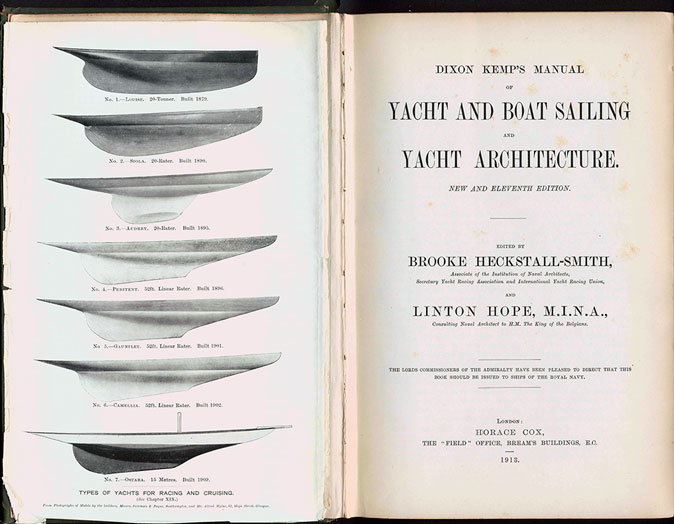
The title page from the eleventh edition of Dixon Kemp’s yachting manual.
Dixon Kemp writes about setting a jackyard topsail in his marvelous and weighty volume, A Manual of Yacht and Boat Sailing, first published in 1878. There may be no greater authority on early yachting than the jovial Mr. Kemp. He edited nine editions of A Manual Of Yacht And Boat Sailing before his death in 1899. The contents, covering a broad sweep of then fashionable and successful types of craft, were updated in later editions as yachting and yacht racing developed. Brooke Heckstall-Smith edited the tenth in 1904 and by the eleventh and last edition, published in 1913 in two volumes, it was then titled Dixon Kemp’s Manual Of Yacht And Boat Sailing And Naval Architecture.
Born in 1839 at Ryde, Isle of Wight, Kemp from the age of 24 was the Solent-area reporter for the influential weekly journal The Field, which published the designs and reviews of small yachts and canoes, as well as stories on the grand scale of British yachting. He made a life-long study of the design and construction of yachts and small boats, and their handling and equipment, supplemented by his wide knowledge of yacht customs, usages, and traditions.
This pdf shows several pages from Kemp’s manual describing the mind-numbing details of setting, sheeting, and taking in a jackyard topsail on a large racing schooner.
Stocky and mustachioed, with “considerable energy and purpose,” as John Leather described him, Kemp got on well with yachtsmen, yacht designers, and builders, and was regarded as the leading yachting authority of his time. Kemp “often sailed on board the fliers of the day” and was present at many important races in Britain and in America. He was there at the first and second AMERICA’s Cup challenges in 1870 and 1871, sailing in New York as the guest of James Ashbury, the owner of the racing schooners CAMBRIA and LIVONIA.
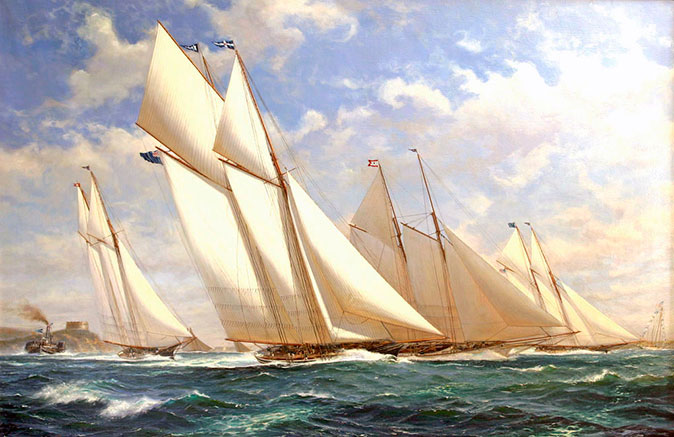
Ashbury Cup, August 16, 1870; painted by Shane Michael Couch (S. M. Couch©/image courtesy Vallejo Maritime Gallery).
In 2003 Shane Michael Couch painted this image, called “Ashbury Cup, August 16,1870” of the schooner CAMBRIA sailing in the first Ashbury Cup. The artist explains on his website, www.vallejogallery.com, that the first Ashbury Cup was held a few months after James Ashbury’s CAMBRIA lost to the American schooner MAGIC in the first defense of the AMERICA’s Cup. Dixon Kemp would have been happy to be aboard.
MORE ON JACKYARD TOPSAILS:
RELIANCE and SHAMROCK III
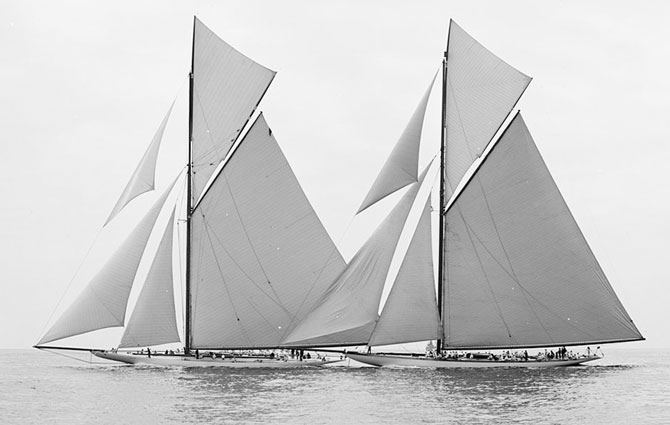
RELIANCE and SHAMROCK III racing in the 1903 AMERICA's Cup (LC-DIG-det-4a15407). Click image to enlarge.
Click on the image above for a large photograph of RELIANCE and SHAMROCK III racing in the 1903 AMERICA’s Cup, also available online in several sizes from the Library of Congress Prints and Photographs Division. The Detroit Publishing Co. took this photograph before the start of the 1903 AMERICA’s Cup. It carries number LC-DIG-det-4a15407. (Choose the large 19.1mb TIFF to view the details described here.)
There is a lot of information in this marvelous photograph. In calm sea conditions, both boats had all canvas up and were moving very well, as the steady curls of the bow waves show. RELIANCE is moving ahead here, stealing air from SHAMROCK III’s headsails. Zoom in on the deck of RELIANCE, the lead boat, to count the crew, 17 men, lining up on the starboard rail to haul in a bit more of the mainsheet. Meanwhile on SHAMROCK’s deck, we see no activity. Aft on the fantail, a man is actually using the bar-taut mainsheet to steady himself. No fine trim of the mainsheet is contemplated here by the afterguard, the guys in the dark suits, on SHAMROCK.

RELIANCE Afterguard (From LC-DIG-det-4a15407).

SHAMROCK III Afterguard (From LC-DIG-det-4a15407.)
You can also zoom in to the head of SHAMROCK III’s staysail, and there you will see a man aloft taking in the view from his seat on the strut. Perhaps he is waiting for a call from the deck, perhaps a call to bring the tack of that jackyard topsail to windward. What if he had had a camera with him to show us what he saw, looking down on the decks of these two competitors!
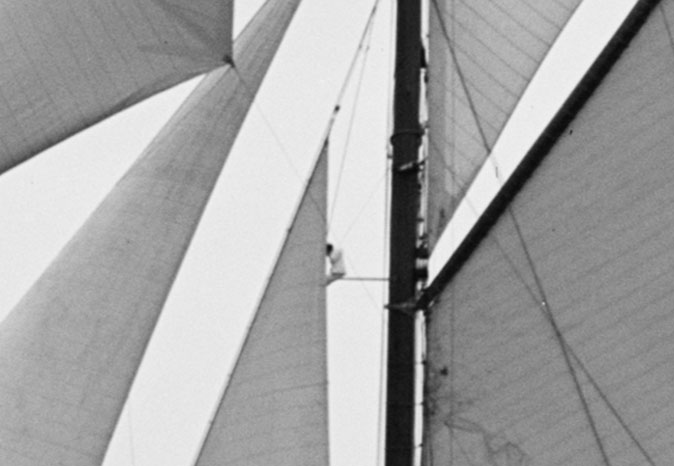
SHAMROCK III man aloft (From LC-DIG-det-4a15407.)
Sailed with a Jackyard Topsail?
Have you sailed with a jackyard topsail? These sails may be scarce today, but you can still see them on classic gaff-rigged yachts such as MARIQUITA, SPARTAN, and JOYANT. The next time you get a chance to see one of these beautiful vessels under sail, you might think about the brave crew wrestling with that tiger aloft. See our companion piece for more details on the joys of setting a jackyard topsail.
